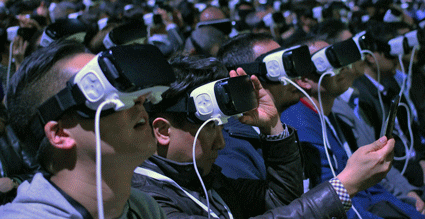Science fiction ranging from Disneyland’s Tomorrowland to Star Wars and Star Trek and beyond contains lessons for how we got here and where we’re going.
_______________________________________________________________________________________
By Brad Berens
When Disneyland first opened in 1955, one of its attractions was a Tomorrowland that looked firmly forward towards the space race and optimistic techno utopias. Then, a few decades later in 1998, Disneyland remodeled Tomorrowland to reflect a retro-future, a portrait of the future from a more optimistic past. It was a weird nostalgic, backward look forward.
 Today, rumor has it that Tomorrowland will go through another remodel to emphasize Marvel superheroes, Tron and Star Wars — the latter being a futuristic story that takes place “a long time ago, in a galaxy far, far away.”
Today, rumor has it that Tomorrowland will go through another remodel to emphasize Marvel superheroes, Tron and Star Wars — the latter being a futuristic story that takes place “a long time ago, in a galaxy far, far away.”
Outside the land of the Mouse, looking at how science fiction writers and futurists imagined what was coming can be illuminating for what they get right, what they get wrong, and what doesn’t occur to them.
One powerful example comes from a pair of Star Trek: the Next Generation episodes featuring a character named Leah Brahms. Shot nearly 30 years ago and set in the 24th Century, these episodes explored ethical questions about virtual reality that we’re just starting to find urgent today.
In “Booby Trap” (Season 3, Episode 6 from 1989), chief engineer Geordi LaForge (played by LeVar Burton) visits the “holodeck” entertainment environment, where he summons a holographic duplicate of Dr. Leah Brahms, the scientist (played by Susan Gibney) who designed the faster-than-light engines for the Starship Enterprise. LaForge needs to get more energy in order to free the ship from a trap, and he consults with a facsimile of Brahms in order to do so.
Working feverishly to save the Enterprise, LaForge and the virtual Brahms become emotionally entangled, so much so that LaForge is reluctant to end the program once the crisis is over, although he does so after a tender goodbye and a kiss. _________________________________________________________________________________________________
It is not a big stretch to imagine that within a few short years, VR headsets will allow users to scan people and environments as easily as we take photographs with our smart phones today. On the innocuous side, instead of posing for a family picture at the end of Thanksgiving dinner, we might all hold still for a 360 degree scan of the room and its inhabitants that we can revisit later.
_________________________________________________________________________________________________
Here is the “Booby Trap” episode:
“Booby Trap” is a dramatic and affecting episode, but the 1991 followup, “Galaxy’s Child” (Season 4, Episode 16) is where things get interesting. The real Dr. Leah Brahms visits The Enterprise to study the engine modifications that LaForge made with her holodeck replica, although she does not know about the replica. Soon, another crisis occurs, and LaForge and the real Brahms must work together.
The problem for LaForge is that he keeps treating the real Brahms as if she were the facsimile, presuming intimacy that is not there and showing that he knows entirely too much about her (things he learned from interacting with the replica) in an unintentionally weird and stalker-ish way. LaForge learns that the real Brahms is quite a bit different than the program: she is married, for one example (an unpleasant bit of news), and so fiercely protective of her engine design that she resents LaForge’s in-the-field tinkering.
Creeped out and suspicious, Brahms (the real one) digs into the Enterprise’s computer logs and finds the record of the collaboration between LaForge and her replica. LaForge realizes that she is reviewing the recording and bursts into the holodeck just as the real Brahms watches the tender goodbye between LaForge and her replica. The real Brahms is furious: she feels violated by what she regards as LaForge’s voyeuristic, objectifying and trivializing caricature of her.
For the viewers who saw both episodes (available on Netflix), “Galaxy’s Child” twists the audience’s tender, uncritical experience from Booby Trap into a new meaning when it replays key scenes from the earlier episode in the later. We the viewers are put into LaForge’s guilty position for having embraced the holodeck fantasy.
In the end, the real Brahms and LaForge get past his use of her image in the holodeck as they work together (in a way similar to how LaForge worked with the replica) to resolve the second episode’s crisis, and at the end of “Galaxy’s Child” they part as friends.
Here is “Galaxy’s Child.”
What this means in 2018
What’s fascinating about these paired Star Trek episodes is how adeptly they capture problems inherent to virtual reality. The holodeck replica of Dr. Brahms is so convincing that LaForge has genuine difficulty telling the difference between the illusion and the real woman he subsequently meets.
Although today’s virtual reality headsets (Oculus Rift, PlayStation, HTC Vive) can’t yet synthesize artificial personalities on the fly like the holodeck, even a casual exploration of a virtual reality environment can already be confusing. For example, at a virtual reality film festival, I once got dizzy and went to support myself by holding onto a chair that did not actually exist, so I stumbled into the innocent and surprised woman standing next to me (she was very forgiving).
It is not a big stretch to imagine that within a few short years, VR headsets will allow users to scan people and environments as easily as we take photographs with our smart phones today. On the innocuous side, instead of posing for a family picture at the end of Thanksgiving dinner, we might all hold still for a 360 degree scan of the room and its inhabitants that we can revisit later.
However, on a more sinister side, the less ethical among us might create surreptitious scans of other people that could then be inserted elsewhere. If you’re in a virtual conference call with a business associate, will you be sure that it’s actually your colleague across the virtual conference table? Or could it be an entirely different person wearing your colleague’s appearance like a mask.
Or, like Dr. Brahms in Star Trek, will we be horrified if we stumble across virtual videos of ourselves doing things we would never do with people we don’t want to know? Pornography is the obvious edge case scenario with this technology, but even more anodyne uses of other people’s images can get real weird real fast.
If a teenaged girl has a crush on a boy in her high school class who won’t tell her the time if she asks, and if that teenaged girl then creates a VR shrine to the boy with a facsimile of him that she programs and interacts with, then how is that different than the girl who pastes a boy’s yearbook picture onto the door of her locker? The VR replica seems weirder than the yearbook picture, even though in a few short years the level of effort between the two will be about the same. If you flip the genders, then it seems even worse.
_________________________________________________________________________________________________
Even a casual exploration of a virtual reality environment can already be confusing. For example, at a virtual reality film festival, I once got dizzy and went to support myself by holding onto a chair that did not actually exist, so I stumbled into the innocent and surprised woman standing next to me (she was very forgiving).
_________________________________________________________________________________________________
We all know that you can’t make movies about The Avengers and sell tickets to them unless you’re Marvel because of copyright law. Disney owns Marvel, and Marvel owns the copyrights to Captain America, the Hulk, the Black Widow and so on.
But what about the not-for-profit recording and recreation of the appearance of individuals? I’m not talking about celebrities, about whom there is an argument — however specious — that the public has a right to know. Instead, the question is: do I have any rights when it comes to my own image? Alas, the answer is “probably not.”
Star Trek: the Next Generation anticipated these issues starting back in the 1980s, and the show got a lot right.
What Star Trek missed, though, was how quotidian virtual reality will be over the next few years.
The television show imagined that even in the 24th century crewmembers aboard The Enterprise would have to go to an entirely different room in order to play around with virtual reality. This is similar to the early, dialup days of the internet where the computer with the CompuServe account was in the back bedroom and you had to go to the internet. Smart phones changed that, enabling us to bring the internet with us everywhere.
On Star Trek, the holodeck was a rare and limited recreational space. In our near future, virtual (or augmented, or mixed) reality will be everywhere.
And sometimes we won’t know what’s really real.
__________

Brad Berens is the Center’s Chief Strategy Officer.
See all columns from the Center.
February 14, 2018

